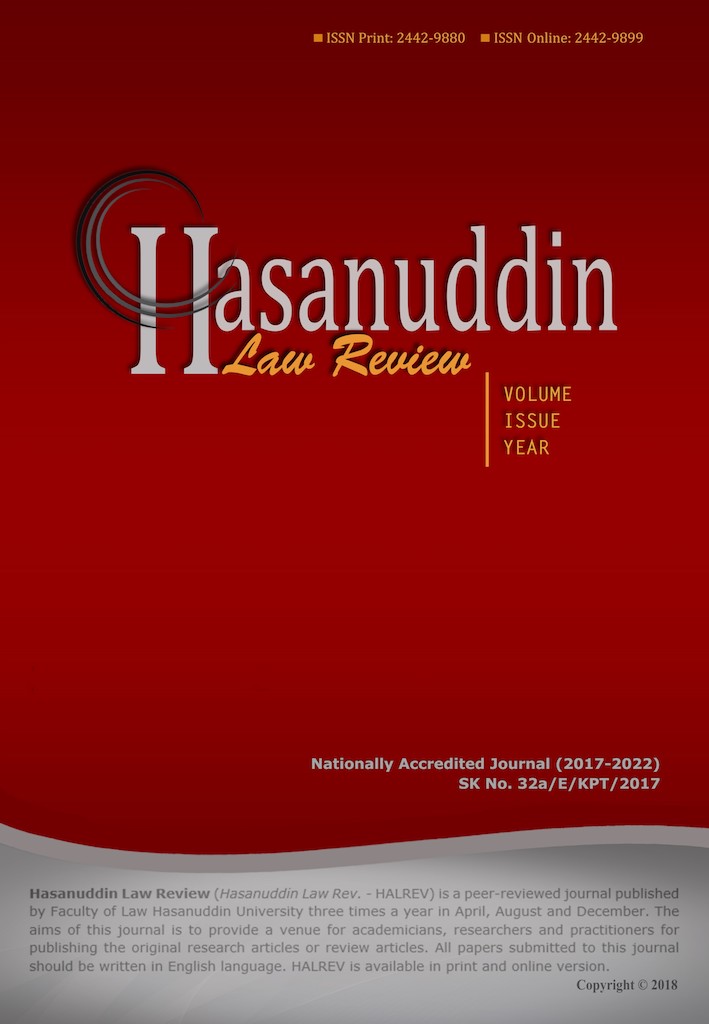Abstract
The ratio between the increased demand and limited land makes affordable housing in urban areas more difficult to accommodate. Indonesia and Malaysia, as populous countries, face problems related to housing access, especially for low-income earners in urban areas. The research was undertaken for two reasons. First, problems related to housing access for low-income earners in urban areas should be solved as soon as possible. Second, it is necessary to conduct a study in order to analyze and compare these two countries in measuring low-income earners on housing access in urban areas. To this end, the normative legal approach was applied. The materials used in this study were relevant statutes, rules, regulations, journals, articles, thesis, seminar papers, and electronic materials. The result showed that the fulfillment of housing access highly depends on the state’s developmental goals. It is also associated with principles of development that each country adheres to. The government is expected to provide accurate data in measuring low-income earners on housing access. Identification of beneficiaries by combining income classification and ability to housing access may facilitate policymakers with ease when taking affirmative measures. It is necessary to suggest initiative collaboration involving academicians, business sectors, community, and government (ABCG) in Indonesia and Malaysia to provide adequate housing in urban areas.References
Al Hikam, H. A. (2019, April 23). OJK Sebut Cuma 60% Orang RI Punya Rekening Bank, Retrieved from https://finance.detik.com/moneter/d-4522143/ojk-sebut-cuma-60-orang-ri-punya-rekening-bank
Asek, B. M. (2012). Implications of the People’s Housing Programme Policy, Journal of Administrative Science, 9(2), Retrieved from https://jas.uitm.edu.my/images/2012_DEC/5.pdf
Bilal, M., Meera, A. K. M., & Razak, D. A. (2019). Issues and Challenges in Contemporary Affordable Public Housing Schemes in Malaysia: Developing an Alternative Model, International Journal of Housing Markets and Analysis, 12(6), https://doi.org/10.1108/IJHMA-11-2018-0091
Direktorat Jenderal Anggaran Kementerian Keuangan. (2015). Peranan APBN Dalam Mengatasi Backlog Perumahan Bagi Masyarakat Berpenghasilan Rendah (MBR), Retrieved from http://www.anggaran.kemenkeu.go.id/api/Medias/d5d98b36-3ed8-4b9f-9d95-b95a6e8878cf
Hossain, A. A. (2012). Macroeconomic and Monetary Policy Issues in Indonesia, Abingdon: Routledge
Indrianingrum, L. (2016). Rencana Kepemilikan Rumah Bagi Masyarakat Berpenghasilan Rendah (Studi Kasus Kelurahan Tanjungmas Kota Semarang). Jurnal Teknik Sipil Dan Perencanaan, 18(1), 15–20. https://doi.org/10.15294/jtsp.v18i1.6690
Ismail, D. S. (2019). Rethinking Housing : Between State, Market and Society.
Jamaluddin, N. B., Abdullah, Y. A., & Hamdan, H. (2016). Encapsulating the delivery of affordable housing: An overview of Malaysian practice. MATEC Web of Conferences, 66, 1–8. https://doi.org/10.1051/matecconf/20166600047
Jayasooria, D. (2020). "Localizing SDGs among B40 Neighborhoods in Klang Valley, Malaysia: Challenges, Possibilities, and Lessons Drawn from the Urban Grasroots, Siri Kertas Kajian Etnik UKM
Jeevanandam, C., & Veerappan, M. (2019). A Study on the Role of National Housing Bank ( NHB ) in Housing Finance. 8(1), 93–95, Retrieved from https://www.trp.org.in/wp-content/uploads/2019/07/AJMS-Vol.8-No.1-January-March-2019-pp.93-95.pdf
Joshi, D. (2020). Rethinking Malaysia’s Income Reclassification. (2), Retrieved from https://refsa.org/wp-content/uploads/2020/03/Final_Income-Reclassification_B20.pdf
Kementerian Komunikasi dan Informatika RI. (2020, September 17). Akselerasi Penyediaan Rumah Bagi Masyarakat Berpenghasilan Rendah, Retrieved from https://kominfo.go.id/content/detail/29464/akselerasi-penyediaan-rumah-bagi-masyarakat-berpenghasilan-rendah/0/berita
Khazanah Research Institute. (2019). Rethinking Housing: Between State, Market and Societyâ€, Kuala Lumpur: Khazanah Research Institute, Retrieved from http://www.krinstitute.org/assets/contentMS/img/template/editor/Rethinking%20Housing%20(Full%20Report)-%20EN%20Version.pdf
Kurniati, N. (2014). Pemenuhan Hak Atas Tanah Perumahan dan Permukiman, Padjajaran Jurnal Ilmu Hukum, 1(1), https://doi.org/10.22304/pjih.v1n1.a5
Leong, S. K. (2019, February 14), A Look at Every Aspect of Home Ownership, Retrieved from https://www.nst.com.my/property/2019/02/460076/look-every-aspect-home-ownership
Mangeswuri, D. R. (2016), Kebijakan Pembiayaan Perumahan Melalui Fasilitas Likuiditas Pembiayaan Perumahan (FLPP), Jurnal Ekonomi & Kebijakan Publik, 7(1), Retrieved from https://jurnal.dpr.go.id/index.php/ekp/article/view/410/314
MD Dahlan, N. H. (2011). Comparative Housing Sale and Purchase Agreements Under the Malaysia, Singapore, and New South Wales Housing Laws, Kedah: Universiti Utara Malaysia Press
Ministry of Housing and Local Government Malaysia. (2011). Housing in the New Millenium – Malaysian Perspective, Retrieved from https://ehome.kpkt.gov.my/index.php/pages/view/297
Mohd-Rahim, F. A., Zainon, N., Sulaiman, S., Lou, E., Zulkifli, N. H., Ayob, M. F. (2019). Factors Affecting the Ownership of Low-cost Housing for Socio-Economic Development Malaysia, Journal of Building Performance, 10(1), Retrieved from http://spaj.ukm.my/jsb/index.php/jbp/article/view/280
Mumin, M. H., & Zainol, F. A. (2016). Causes of Abandoned Housing Projects in Malaysia – The Stakeholders Views, Asian Journal of Knowledge Management, 3(1), Retrieved from http://www.asianikm.com/ejournal/index.php/aikm/article/view/15
Nair, S., & Sagaran, S. (2015). Poverty in Malaysia: Need for a Paradigm Shift, Institutions and Economics, 7(3), Retrieved from https://ijie.um.edu.my/index.php/ijie/article/view/5020/2858
National Housing Department Ministry of Housing and Local Government. (2016). National Housing Policy, Retrieved from http://rehdainstitute.com/wp-content/uploads/2016/03/nhp.pdf
Samad, D., Zainon, N., Mohd Rahim, F. A., Lou, E. (2017). Malaysian Affordability Housing Policies Revisited, Open House International, 42(1), https://doi.org/10.1108/OHI-01-2017-B0007
Sulaiman, N., Baldry, D., & Ruddock, L. (2005). Can Low Cost Housing in Malaysia be Considered as Affordable Housing?, 12th Annual European Real Estate Society Conference, Dublin, Ireland, https://www.researchgate.net/publication/260036919_CAN_LOW_COST_HOUSING_IN_MALAYSIA_BE_CONSIDERED_AS_AFFORDABLE_HOUSING
Shuid, S. (2010). Low Income Housing Allocation System in Malaysia: Managing Housing Need for the Poor, 22nd IInternational Housing Research Conference, Istanbul, Turkey, Retrieved from https://core.ac.uk/download/pdf/300367374.pdf
Swee-Hock, S. (2007). The Population of Malaysia, Singapore: Institute of Southeast Asian Studies Publishing
The World Bank. (2019). Indonesia Economic Quarterly: Investing in People, Retrieved from https://openknowledge.worldbank.org/bitstream/handle/10986/33033/144221BA.pdf?sequence=5&isAllowed=y
Tighe, J.R., & Mueller, E.J. (2013). The Affordable Housing Reader, Abingdon: Routledge
Tobi, S. U. M., Jasimin, T. H., & Rani, W. N. M. W. M. (2020). Overview of Affordable Housing from Supply and Demand Context in Malaysia. IOP Conference Series: Earth and Environmental Science, https://doi.org/10.1088/1755-1315/409/1/012010
UN-HABITAT. (2008). The Role of Government in the Housing Market: The Experiences from Asia, Retrieved from https://unhabitat.org/the-role-of-government-in-the-housing-market-the-experiences-from-asia
Woo, K. H. (2018). Affordable Housing Policy in Penang State of Malaysia, Global Encyclopedia of Public Administration, Public Policy and Governance, https://doi.org/10.1007/978-3-319-31816-5_3671-1
Zaid, S., & Graham, P. (2011). Low-Cost Housing in Malaysia: A Contribution to Sustainable Development?, 1st International Postgraduate Conference on Engineering, Designing and Developing the Built Environment for Sustainable Wellbeing, Queensland, Australia, https://doi.org/10.13140/RG.2.1.2715.9120
Zamri, A. M. (2019). Homeownership Gaps Among the Middle Income Group in Malaysia, Journal of Science, Technology and Innovation Policy, 5(2), Retrieved from https://www.semanticscholar.org/paper/Homeownership-Gaps-among-the-Middle-Income-Group-in-Zamri/9d85078e433deb7f13ed4dba5a00db5172babfea
- The journal holds the copyright for each article published with work licensed simultaneously under a Creative Commons Attribution 4.0 International License, which allows others to share the work with an acknowledgment of the authorship and early publication of the work in this journal.
- Authors must agree to the copyright transfer agreement by checking the Copyright Notice column at the initial stage when submitting the article.

